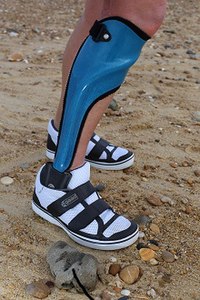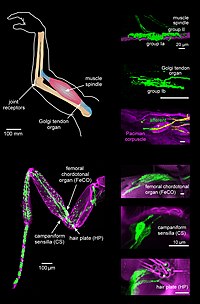
Biomechanical Effects of Chronic Ankle Instability on the Talar Cartilage Matrix: The Value of T1ρ Relaxation Mapping Without and With Mechanical Loading
Sign Up to like & getrecommendations! Published in 2022 at "Journal of Magnetic Resonance Imaging"
DOI: 10.1002/jmri.28267
Abstract: T1ρ mapping has been proposed for the detection of early cartilage degeneration associated with chronic ankle instability (CAI). However, there are limited data surrounding the influence of ankle loading on T1ρ relaxation. read more here.
Keywords: biomechanical effects; chronic ankle; cartilage; relaxation ... See more keywords

Preoperative MRI is helpful but not sufficient to detect associated lesions in patients with chronic ankle instability
Sign Up to like & getrecommendations! Published in 2017 at "Knee Surgery, Sports Traumatology, Arthroscopy"
DOI: 10.1007/s00167-017-4567-x
Abstract: PurposeThe aim of this study was to determine the reliability and validity of preoperative magnetic resonance imaging (MRI) scans for the detection of additional pathologies in patients with chronic ankle instability (CAI) compared to arthroscopic findings.MethodsPreoperative… read more here.
Keywords: ankle instability; chronic ankle; mri helpful; patients chronic ... See more keywords

Arthroscopic all-inside ATFL and CFL repair is feasible and provides excellent results in patients with chronic ankle instability
Sign Up to like & getrecommendations! Published in 2019 at "Knee Surgery, Sports Traumatology, Arthroscopy"
DOI: 10.1007/s00167-019-05676-z
Abstract: Purpose Chronic ankle instability has been described as presenting with complete tears of both the anterior talofibular ligament (ATFL) and calcaneofibular ligament (CFL) in 20% of cases. Arthroscopic techniques to treat chronic ankle instability are… read more here.
Keywords: chronic ankle; atfl cfl; arthroscopic inside; ankle instability ... See more keywords

Assessment of evertor weakness in patients with chronic ankle instability: Functional versus isokinetic testing
Sign Up to like & getrecommendations! Published in 2017 at "Clinical Biomechanics"
DOI: 10.1016/j.clinbiomech.2016.12.002
Abstract: Background: Ankle sprain is the most common sport‐related injury and eccentric weakness of ankle evertors is regarded as a significant muscular deficit related to chronic ankle instability. However, the eccentric performance of the evertors is… read more here.
Keywords: chronic ankle; ankle instability; weakness; isokinetic testing ... See more keywords

Comparison between subtalar joint quantitative kinematic 4-D CT parameters in healthy volunteers and patients with joint stiffness or chronic ankle instability: A preliminary study.
Sign Up to like & getrecommendations! Published in 2019 at "European journal of radiology"
DOI: 10.1016/j.ejrad.2019.03.001
Abstract: OBJECTIVE to compare quantitative kinematic 4-D CT parameters between healthy volunteers and pathologic patients (joint stiffness or chronic ankle instability). METHODS Thirteen healthy volunteers without previous ankle trauma, 18 patients with clinical subtalar joint stiffness… read more here.
Keywords: healthy volunteers; joint stiffness; ankle instability; chronic ankle ... See more keywords

Investigating the anticipatory postural adjustment phase of gait initiation in different directions in chronic ankle instability patients.
Sign Up to like & getrecommendations! Published in 2018 at "Journal of bodywork and movement therapies"
DOI: 10.1016/j.jbmt.2017.03.016
Abstract: OBJECTIVE The main objective of the present study was to analyze how supra spinal motor control mechanisms are altered in different directions during anticipatory postural phase of gait initiation in chronic ankle instability patients. It… read more here.
Keywords: chronic ankle; anticipatory postural; ankle instability; phase gait ... See more keywords

T1ρ MRI of the talar articular cartilage is increased in those with chronic ankle instability.
Sign Up to like & getrecommendations! Published in 2019 at "Osteoarthritis and cartilage"
DOI: 10.1016/j.joca.2018.12.019
Abstract: OBJECTIVE To determine if individuals with chronic ankle instability (CAI) demonstrate different talar cartilage T1ρ relaxation times compared to uninjured controls. DESIGN Fifteen CAI (21.13 ± 1.81 years, 4.00 ± 2.07 previous ankle sprains) and fifteen controls (21.07 ± 2.55 years,… read more here.
Keywords: ankle instability; relaxation; relaxation times; chronic ankle ... See more keywords

Predicting dynamic balance improvements following 4-weeks of balance training in chronic ankle instability patients.
Sign Up to like & getrecommendations! Published in 2019 at "Journal of science and medicine in sport"
DOI: 10.1016/j.jsams.2018.11.001
Abstract: OBJECTIVES Balance training typically features as a central component of exercise-based rehabilitation programs for patients with lateral ankle sprain and chronic ankle instability (CAI). The purpose of this study was to conduct a responder/non-responder analysis… read more here.
Keywords: ankle instability; dynamic balance; treatment; chronic ankle ... See more keywords

Self-reported chronic ankle instability effects on the development of fitness during an Infantry Commanders Course.
Sign Up to like & getrecommendations! Published in 2021 at "Journal of science and medicine in sport"
DOI: 10.1016/j.jsams.2021.04.016
Abstract: OBJECTIVES To determine whether self-reported chronic ankle instability (CAI) affects the physical performance of soldiers during army training, in routine army fitness tests and other sensorimotor tests. DESIGN Prospective cohort comparison. METHODS Soldiers enrolled on… read more here.
Keywords: soldiers cai; reported chronic; chronic ankle; course ... See more keywords

Chronic ankle instability is associated with proprioception deficits: A systematic review and meta-analysis
Sign Up to like & getrecommendations! Published in 2020 at "Journal of Sport and Health Science"
DOI: 10.1016/j.jshs.2020.09.014
Abstract: Highlights • The deficits of joint position sense (JPS) and kinesthesia exist in the injured ankles of patients with chronic ankle instability (CAI).• When compared with the uninjured contralateral side, the kinesthesia, passive and active… read more here.
Keywords: chronic ankle; ankle; proprioception deficits; ankle instability ... See more keywords

Chronic Ankle Instability - Mechanical vs. Functional.
Sign Up to like & getrecommendations! Published in 2022 at "Zeitschrift fur Orthopadie und Unfallchirurgie"
DOI: 10.1055/a-1696-2503
Abstract: Chronic ankle instability arises from three interacting contributing factors: mechanical ankle instability, functional ankle instability, and perceived ankle instability. To decide on the most appropriate individual recommendation for therapeutic options, it is necessary to assess… read more here.
Keywords: instability mechanical; chronic ankle; mechanical instability; instability ... See more keywords